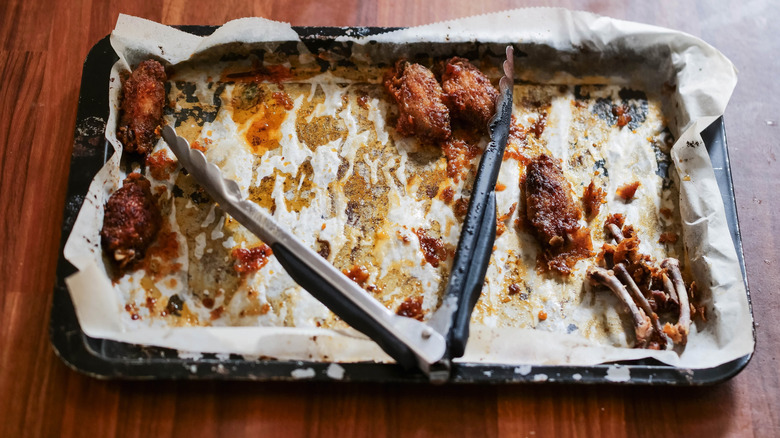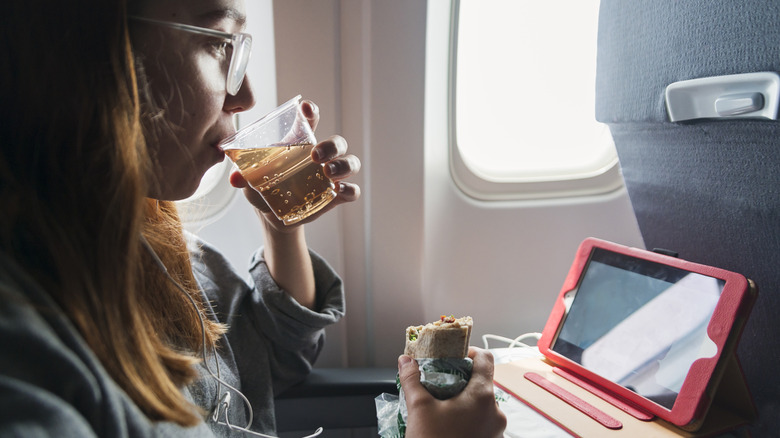The Types Of Food You Should Never Bring On A Plane, According To A Flight Attendant
Airline food was once the punchline to many a joke, but in-flight meals prepared by airline staff have been improving in recent years. The problem is, you may only get fed if you're flying first class or overseas, leaving economy passengers with a dismal selection of (not so) cheap airline snacks and drinks. Luckily, the Transportation Security Administration (TSA) allows you to bring most solid foods in your carry-on luggage. But veteran flight attendant Barbi warns that not all foods are, shall we say, socially acceptable. "Be cognizant of other people around you. The old adage of thinking about how your actions are affecting others in a small, confined, and not-private space goes a long way," she cautioned. In short: Avoid smelly foods.
Barbi mentioned a few specific items known for their odor factor, noting that "Tuna in a can ... can be messy and hard to mix and manage in an airplane seat." A tuna salad or sandwich, too, can also be stinky. She also observed, "If you're flying in the U.S., kimchi is probably going to be on that list of bad ideas. We in the States aren't used to smelling it much, and it can be quite an overwhelming smell." There is one notoriously problematic food she gives a pass to, however, on the grounds of good nutrition. While she admitted that hard-boiled eggs can have an offensive odor, she excused this by adding, "They are truly a great item that is packed with protein, healthy fats, and not processed at all ... Just don't bring half a dozen. One or two shouldn't be a huge problem."
Anything that makes a mess is terrible for your flight
Bringing the wrong kind of food on a plane can have serious consequences. While we haven't heard of any delays caused by a passenger noshing on Limburger cheese, a 2023 Southwest Airlines flight was delayed for an hour on account of spilled fried rice. Other potential mess-makers, according to Barbi, include: "Anything with shells, bones or other detritus you'll need a bag for." She mentioned bone-in wings and peel-and-eat shrimp, but hard-boiled eggs could present a problem, too, unless you've pre-peeled them. As she pointed out, "If it's messy at home or in a restaurant, it's 10 times more messy in a cramped seat on an airplane."
According to Barbi, good airline etiquette also requires a little respect. "Clean up after yourself. Don't leave a mess for the flight attendants to clean up after you," she advised. As a part of the tidying process, you should try to break down any bulky packaging your self-catered meals may have come in, such as pizza boxes. "We have only so much space for trash on most airplanes," Barbi explained.
These foods are acceptable airline fare
So what are some inoffensive options for eating on an airplane? Sandwiches are usually a pretty good bet, although Barbi requested you keep these "low on the odor factor." Turkey or ham and cheese will work, as will chicken salad, but tuna or egg salad might not meet the sniff test. A meatball sub or Philly cheesesteak, while delicious, is way too messy for in-flight consumption.
Fruit and vegetables make for a healthy snack, and those that contain more water may even help keep you hydrated, in-flight. Just consider prepping them ahead of time to remove any peels, seeds, or cores that would otherwise need to be discarded onboard. Dried fruit makes for neater eating, while nuts are also an option. (Those without shells are best.) Crackers and chips are fine — but dips, not so much. According to TSA rules, salsa and hummus both qualify as liquids; are restricted to containers of 3.4 ounces or less; and must be kept in a one-quart, clear zip-top bag along with all other liquids. (Each passenger may only bring one such bag.) This applies to dressings, as well, so bear this in mind if you're deciding whether to pack a salad.
If your flight is anything other than a short hop, you should also be aware that bringing perishable foods may not be such a great idea. The USDA cautions that any such foods may develop dangerous bacteria if left unrefrigerated for more than two hours. Non-perishables are preferable for the safest mile-high dining.


